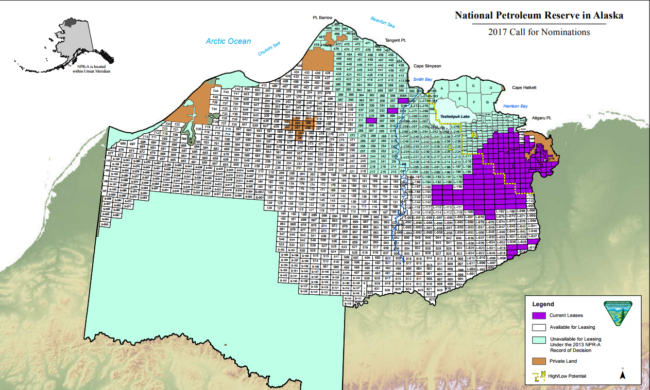
The Trump administration is taking a first step towards potentially opening up new parts of Alaska to oil drilling.
The Bureau of Land Management announced Monday that it will consider allowing oil development in parts of the National Petroleum Reserve on Alaska’s North Slope that are currently protected.
The National Petroleum Reserve-Alaska (NPR-A) is an Indiana-sized chunk of federal land west of Prudhoe Bay. The BLM is asking for input on what parts of the Reserve should be available for drilling, including areas that were blocked off from oil and gas leasing under the Obama administration.
BLM spokesperson Lesli Ellis-Wouters said the announcement is a direct result of an order signed by Interior Secretary Ryan Zinke when he visited Alaska this spring. It ordered the agency to review the existing plan.
“His direction was to review that Integrated Activity Plan, to ensure that we’re promoting a balance of conservation and development,” Ellis-Wouters said.
Ellis-Wouters said the 11 million acres that are now blocked off won’t be available at this year’s oil and gas lease sale. She said at this point, the Interior Department is just gauging industry interest in the region.
And there may be a lot of interest from the oil industry. There have been several big oil discoveries in and around the National Petroleum Reserve-Alaska in the past year. According to BLM, some of the area that’s now off-limits has high potential for oil and gas development.
But Susan Culliney of Audubon Alaska said that part of the Reserve was protected for a reason. It’s near a giant lake that’s key habitat for many species.
“Teshekpuk Lake [and] the special area in and around Teshekpuk Lake are very crucial for wildlife species such as caribou, molting geese, hundreds of thousands of shorebirds congregate in that area,” Culliney said.
The deadline for public comment is September 7.
Elizabeth Harball is a reporter with Alaska's Energy Desk, covering Alaska’s oil and gas industry and environmental policy. She is a contributor to the Energy Desk’s Midnight Oil podcast series. Before moving to Alaska in 2016, Harball worked at E&E News in Washington, D.C., where she covered federal and state climate change policy. Originally from Kalispell, Montana, Harball is a graduate of Columbia University Graduate School of Journalism.




